Study on Long-Term Stability of Lined Rock Cavern for Compressed Air Energy Storage
Abstract
1. Introduction
2. Methods
2.1. Damage Variable of Rock Mass
2.2. Numerical Implementation
3. Validation
4. Engineering Application
4.1. Calculation Model
4.2. Calculation Results
5. Conclusions
- During the first inflation process, the concrete lining will crack and cause a large displacement. During the subsequent filling and deflation process, the maximum displacement of the top lining of the LRC is stable at 10.50 mm, which will have a negative impact on the sealing of the cavern. Hence, the lining should take relevant measures to limit concrete cracking, such as adding fibers, using ribbed steel bars, increasing the reinforcement ratio, etc.
- During the cyclic charging and deflating process, the vertical displacement of the LRC will slowly increase. When the charging and deflating cycle is calculated 100 times, the vertical radial displacement of the rock mass is 8.39 mm, which is greater than the 7.53 mm during the first inflation. This indicates that the deformation of the rock mass of the LRC is a dynamically increasing process during the long-term cyclic filling and deflating process. In the process of designing and calculating the LRC, the calculated value of the last charging and deflating cycle of the design life should be used.
- The vertical displacement of the rock mass is greater than the horizontal direction. The vertical direction of the rock mass will generate a hoop tensile stress and produce plastic deformation. The plastic zone of the rock mass increases with the number of cycles, and the plastic zone of the rock mass is enlarged by 4.71 m2, about 11.49% for 100 cycles compared to the first cycle.
Author Contributions
Funding
Data Availability Statement
Conflicts of Interest
References
- Si, X.; Li, Z.; Yang, H. Auxiliary decision making method for energy storage configuration under uncertainty. Sci. Technol. Eng. 2021, 21, 2699–2704. [Google Scholar]
- Zhang, L.; Ye, T.; Xin, Y. Problems and measures of power grid accommodating large scale wind power. Proc. Chin. Soc. Electr. Eng. 2010, 30, 1–9. [Google Scholar]
- Bazdar, E.; Sameti, M.; Nasiri, F.; Haghighat, F. Compressed air energy storage in integrated energy systems: A review. Renew. Sustain. Energy Rev. 2022, 167, 112701. [Google Scholar] [CrossRef]
- Budt, M.; Wolf, D.; Span, R.; Yan, J. A review on compressed air energy storage: Basic principles, past milestones and recent developments. Appl. Energy 2016, 170, 250–268. [Google Scholar] [CrossRef]
- Wang, Z.; Fang, G.; Wen, X.; Tan, Q.; Zhang, P. Coordinated operation of conventional hydropower plants as hybrid pumped storage hydropower with wind and photovoltaic plants. Energy Convers. Manag. 2023, 277, 116654. [Google Scholar] [CrossRef]
- Rehman, S.; Al-Hadhrami, L.M.; Alam, M.M. Pumped hydro energy storage system: A technological review. Renew. Sustain. Energy Rev. 2015, 44, 586–598. [Google Scholar] [CrossRef]
- Sun, Z.; Zhang, J.; Luo, H.; Yao, Y.; Wang, N. Superior capacitive energy-storage performance in Pb-free relaxors with a simple chemical composition. J. Am. Chem. Soc. 2023, 145, 6194–6202. [Google Scholar] [CrossRef] [PubMed]
- Gu, H.; Chen, Y.; Yao, X.; Huang, L.; Zou, D. Review on heat pump (HP) coupled with phase change material (PCM) for thermal energy storage. Chem. Eng. J. 2023, 455, 140701. [Google Scholar] [CrossRef]
- Liu, K.; Yuan, Z.F.; Zhao, H.X.; Shi, C.H.; Zhao, F. Properties and applications of shape-stabilized phase change energy storage materials based on porous material support—A review. Mater. Today Sustain. 2023, 21, 100336. [Google Scholar] [CrossRef]
- Tong, Z.; Cheng, Z.; Tong, S. A review on the development of compressed air energy storage in China: Technical and economic challenges to commercialization. Renew. Sustain. Energy Rev. 2021, 135, 110178. [Google Scholar] [CrossRef]
- Razmi, A.R.; Soltani, M.; Ardehali, A.; Gharali, K. Design, thermodynamic, and wind assessments of a compressed air energy storage (CAES) integrated with two adjacent wind farms: A case study at Abhar and Kahak sites, Iran. Energy 2021, 221, 119902. [Google Scholar] [CrossRef]
- Olabi, A.G.; Wilberforce, T.; Ramadan, M.; Abdelkareem, M.A.; Alami, A.H. Compressed air energy storage systems: Components and operating parameters—A review. J. Energy Storage 2021, 34, 102000. [Google Scholar] [CrossRef]
- Jafarizadeh, H.; Soltani, M.; Nathwani, J. Assessment of the Huntorf compressed air energy storage plant performance under enhanced modifications. Energy Convers. Manag. 2020, 209, 112662. [Google Scholar] [CrossRef]
- Davis, L.; Schainker, R. Compressed air energy storage (caes): Alabama electric cooperative mcintosh plant-overview and operational history. In Proceedings of the Electricity Storage Association Meeting, Washington, DC, USA, 2–3 November 2006. [Google Scholar]
- Yang, C.; Wang, T. Advance in deep underground energy storage. Chin. J. Rock Mech. Eng. 2022, 41, 1729–1759. [Google Scholar]
- Wan, M.; Ji, W.; Shang, H. Key issues and treatment technologies of underground salt cavern prospecting for compressed air energy storage. South. Energy Constr. 2023, 10, 26–31. [Google Scholar]
- Kim, H.M.; Rutqvist, J.; Jeong, J.H.; Choi, B.H. Characterizing excavation damaged zone and stability of pressurized lined rock caverns for underground compressed air energy storage. Rock Mech. Rock Eng. 2013, 46, 1113–1124. [Google Scholar] [CrossRef]
- Shidahara, T.; Nakagawa, K.; Ikegawa, Y. Demonstration Study for the Compressed Air Energy Storage Technology by the Hydraulic Confining Method at the Kamioka Testing Site; Abiko Research Laboratory: Abiko, Japan, 2001. [Google Scholar]
- Li, P.; Jiang, Z.; Xia, C. Research on Key Technologies for the Construction of High-Pressure Sealed Underground Gas Storage for Compressed Air Energy Storage Power Stations; China Power Construction Group Zhongnan Survey and Design Institute Co., Ltd.: Changsha, China, 2018. [Google Scholar]
- Jiang, Z.-M.; Li, P.; Zhao, H.-B. Experimental study on performance of shallow rock cavern for compressed air energy storage. Rock Soil Mech. 2020, 41, 235–241. [Google Scholar]
- Xu, Y.J.; Zhou, S.W.; Xia, C.C.; Zhao, H.; Xue, X. Three-dimensional thermo-mechanical analysis of abandoned mine drifts for underground compressed air energy storage: A comparative study of two construction and plugging schemes. J. Energy Storage 2021, 39, 102696. [Google Scholar] [CrossRef]
- Xu, X.L.; Karakus, M. A coupled thermo-mechanical damage model for granite. Int. J. Rock Mech. Min. Sci. 2018, 103, 195–204. [Google Scholar] [CrossRef]
- Zhou, S.W.; Xia, C.C.; Hu, Y.S.; Zhou, Y.; Zhang, P.Y. Damage modeling of basaltic rock subjected to cyclic temperature and uniaxial stress. Int. J. Rock Mech. Min. Sci. 2015, 77, 163–173. [Google Scholar] [CrossRef]
- Zhou, S.W.; Xia, C.C.; Zhao, H.B.; Mei, S.H.; Zhou, Y. Statistical damage constitutive model for rocks subjected to cyclic stress and cyclic temperature. Acta Geophys. 2017, 65, 893–906. [Google Scholar] [CrossRef]
- Miao, S.J.; Yang, P.J.; Hui, W.; Liang, M.; Wang, Y. Study on fatigue rheological damage model of siltstone under cyclic loading. Eng. Mech. 2022, 39, 70–80. [Google Scholar]
- Li, Z.; Yang, F.; Fan, J.; Jiang, D.; Ambre, J. Fatigue effects of discontinuous cyclic loading on the mechanical characteristics of sandstone. Bull. Eng. Geol. Environ. 2022, 81, 336. [Google Scholar] [CrossRef]
- Jiang, Z.; Qin, S.; Tang, D. Numerical study on cumulative damage characteristics of surrounding rock of compressed air energy storage underground gas storage. Chin. J. Geotech. Eng. 2020, 42, 230–238. [Google Scholar]
- Yuan, X.; Liu, H.; Liu, J. Constitutive model of non-penetrating fractured rock mass based on macro-mesoscopic damage coupling. Rock Soil Mech. 2015, 36, 2804–2814. [Google Scholar]
- Huang, Z.Y.; Wagner, D.; Bathias, C. Cumulative fatigue damage in low cycle fatigue and gigacycle fatigue for low carbon–manganese steel. Int. J. Fatigue 2011, 33, 115–121. [Google Scholar] [CrossRef]
- Li, S.; Xu, J.; Tao, Y. Rock low-cycle fatigue damage model and damage variable expression method. Rock Soil Mech. 2009, 30, 1611–1614+1619. [Google Scholar]
- Yang, G.; Xie, D. Coupling analysis on the macro-damage and meso-damage of rock masses. In Proceedings of the Sixth National Conference on Rock Mechanics and Engineering, Wuhan, China, 2 October 2000; Volume 10. [Google Scholar]
- Lemaitre, J. A Course on Damage Mechanics; Springer Science & Business Media: Berlin/Heidelberg, Germany, 1996. [Google Scholar]
- Jing, H.; Wu, J.; Yin, Q.; Wang, K. Deformation and failure characteristics of anchorage structure of surrounding rock in deep roadway. Int. J. Min. Sci. Technol. 2020, 30, 593–604. [Google Scholar] [CrossRef]
- Wu, J.; Jing, H.; Gao, Y.; Meng, Q.; Yin, Q.; Du, Y. Effects of carbon nanotube dosage and aggregate size distribution on mechanical property and microstructure of cemented rockfill. Cem. Concr. Compos. 2022, 127, 104408. [Google Scholar] [CrossRef]
- Wu, J.; Wong, H.S.; Zhang, H.; Yin, Q.; Jing, H.; Ma, D. Improvement of cemented rockfill by premixing low-alkalinity activator and fly ash for recycling gangue and partially replacing cement. Cem. Concr. Compos. 2024, 145, 105345. [Google Scholar] [CrossRef]
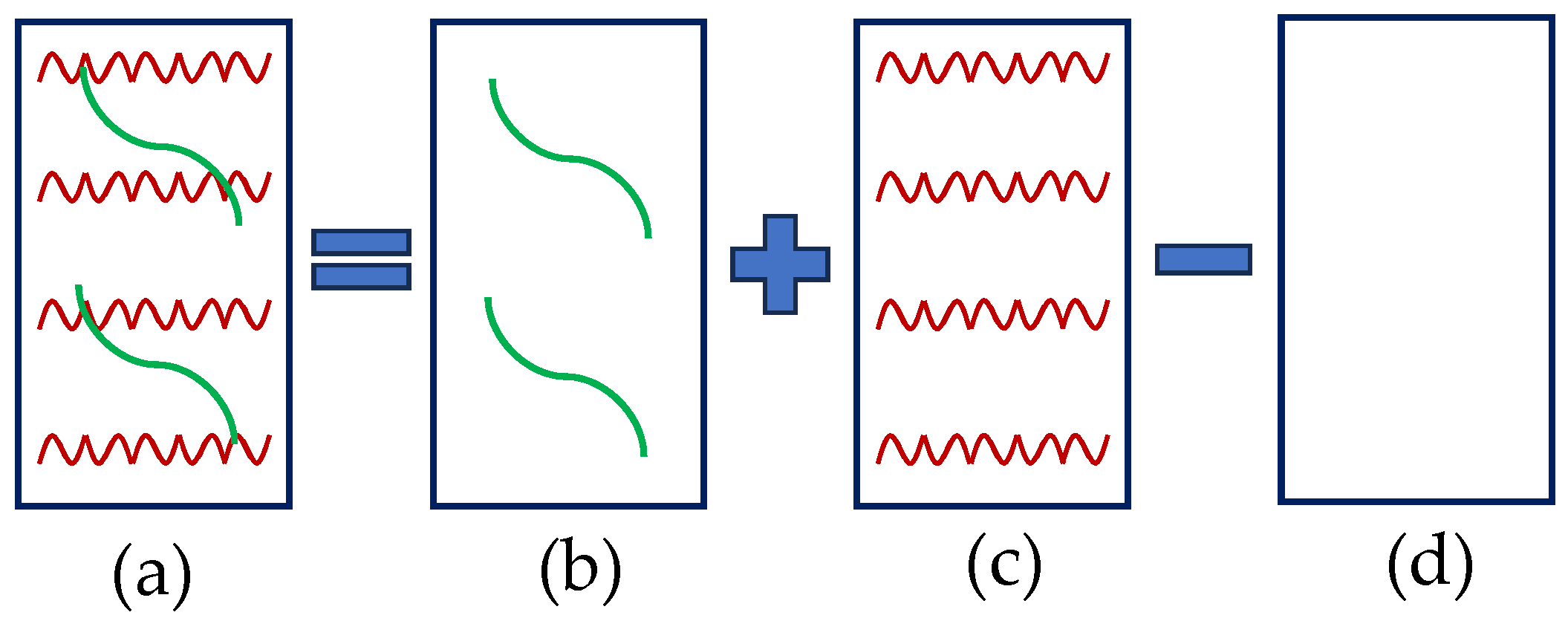
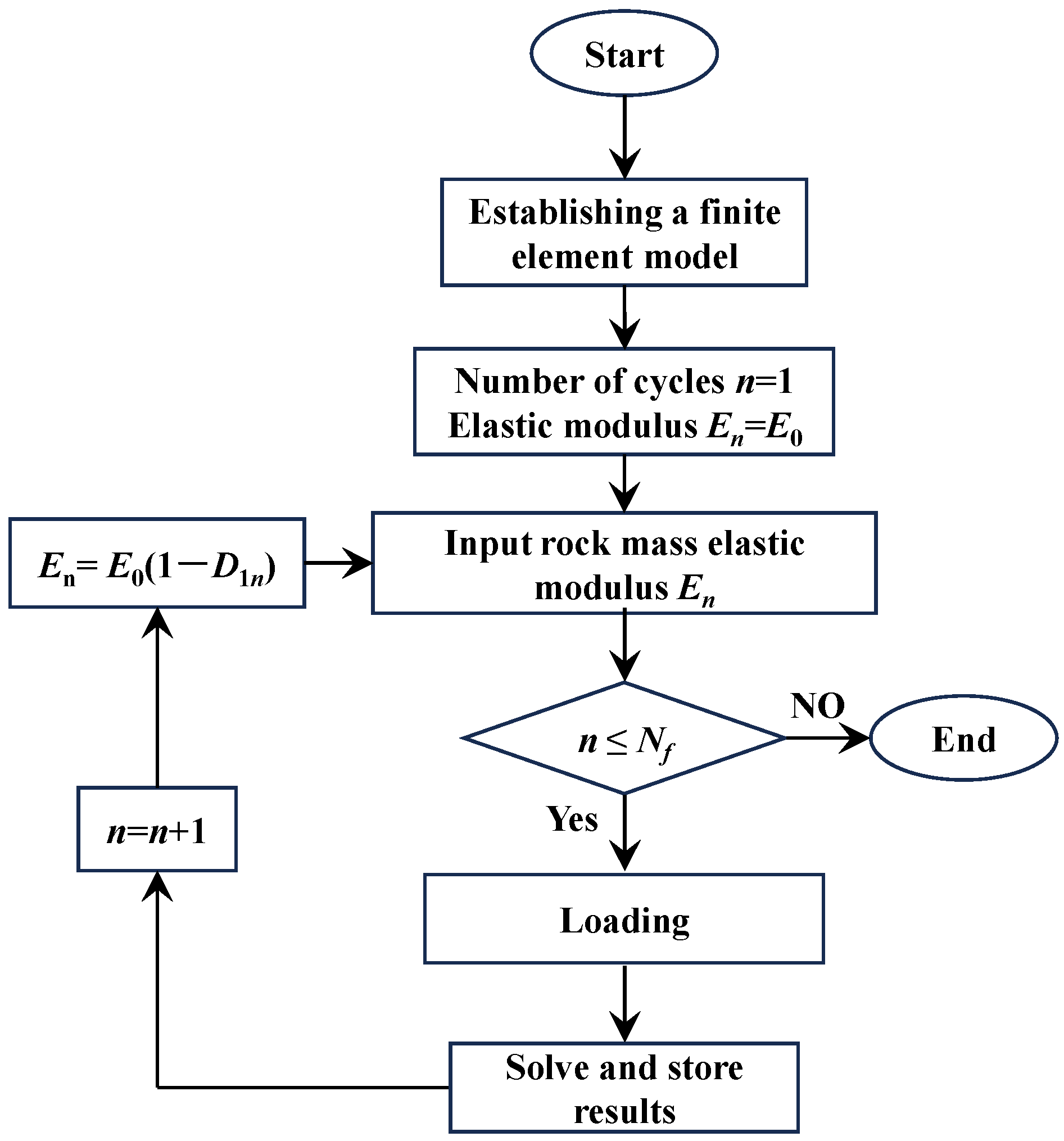
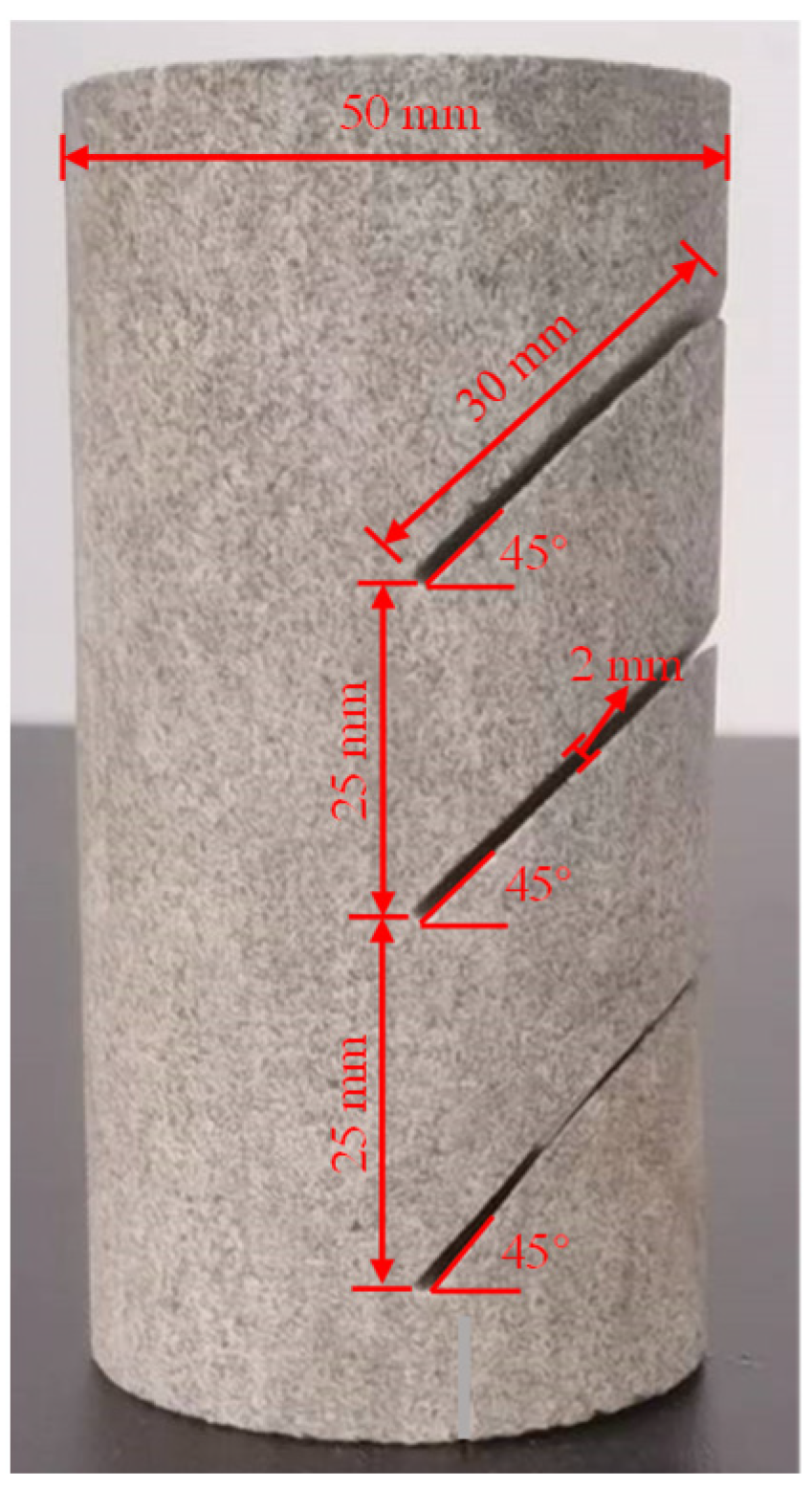
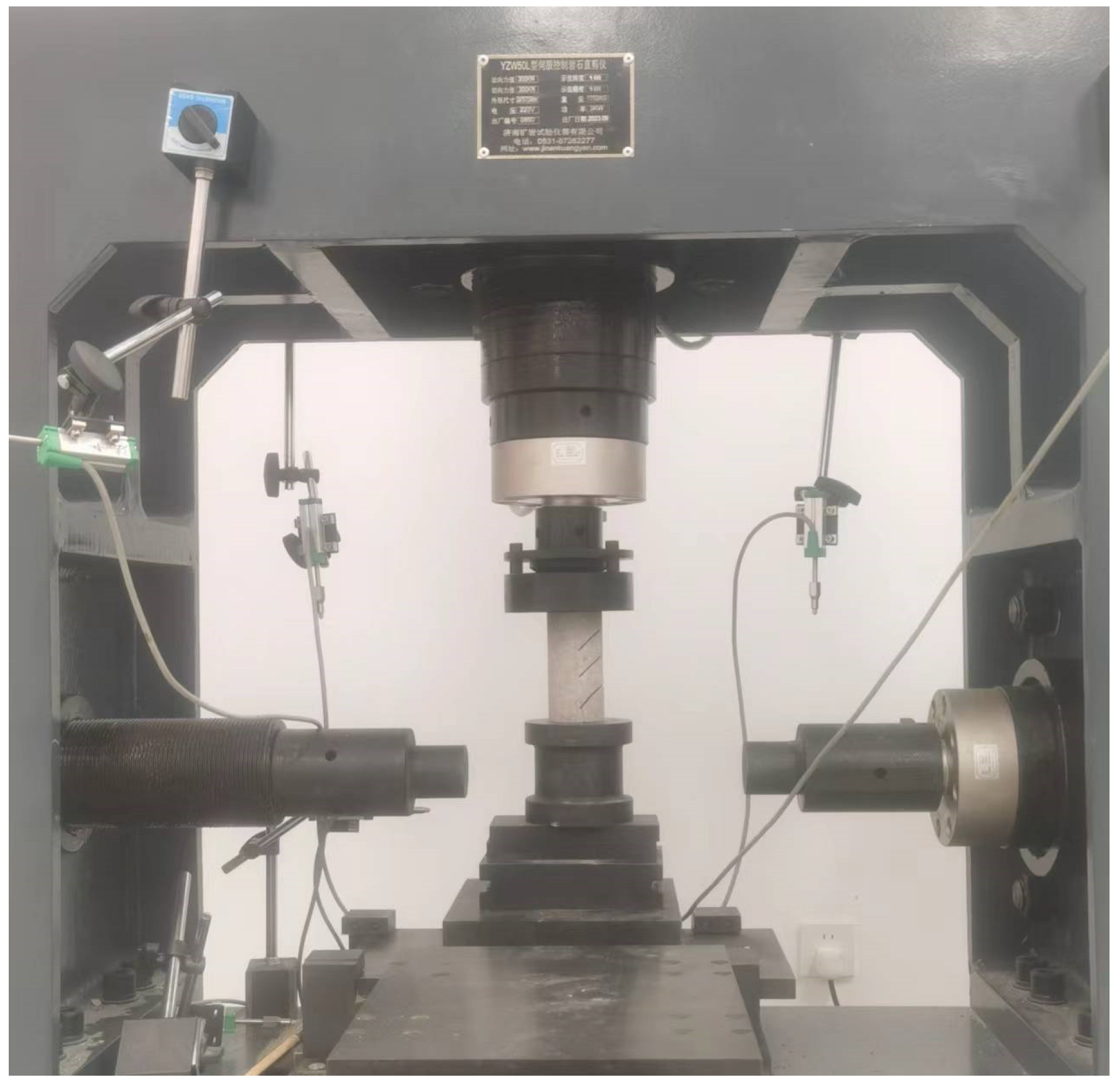


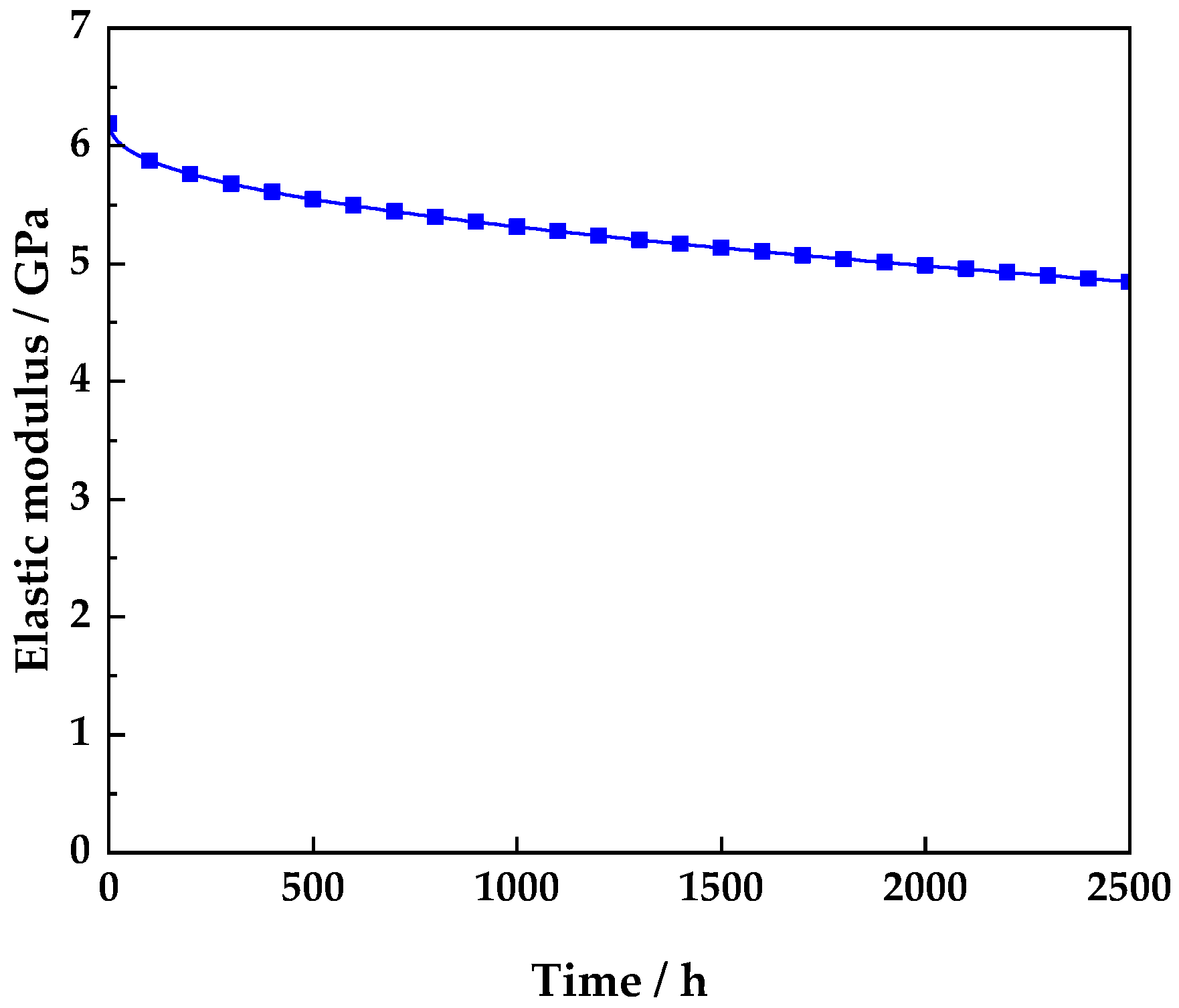

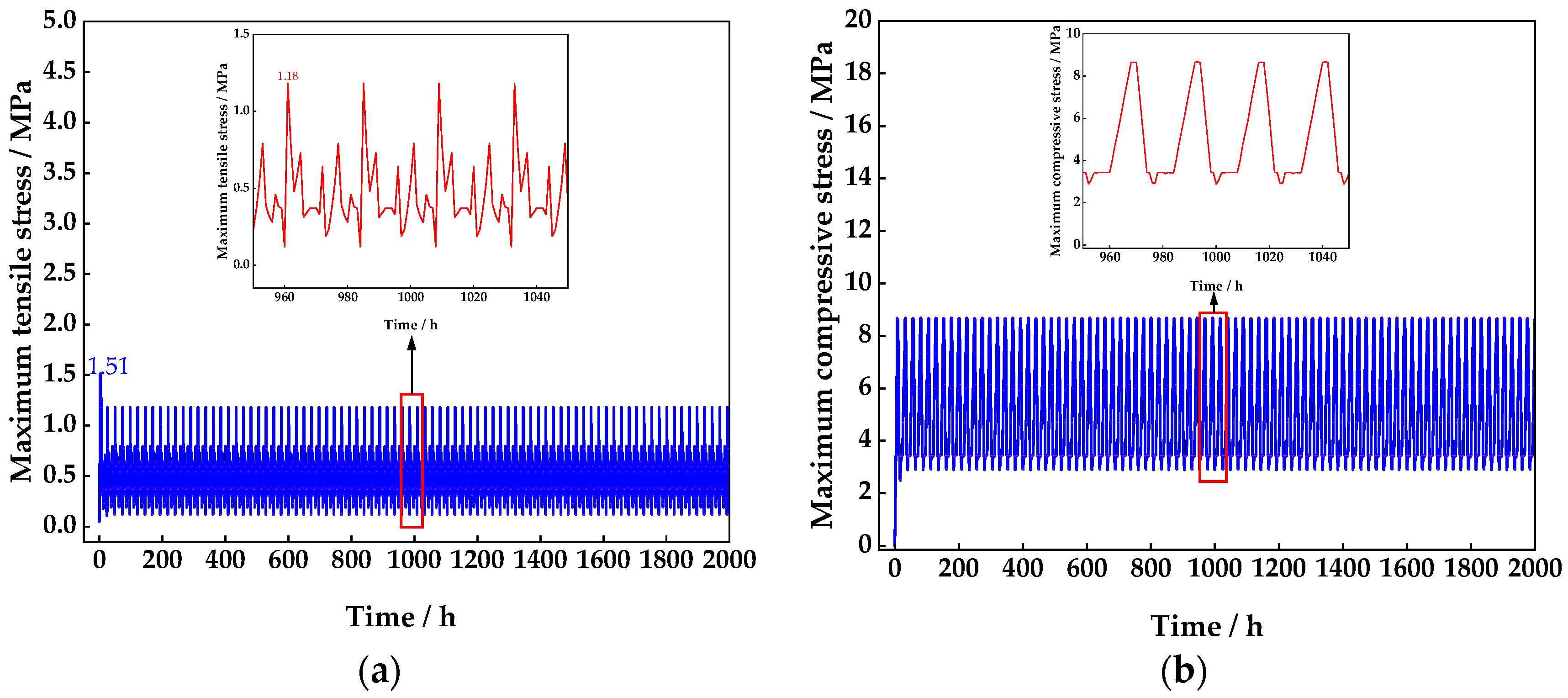

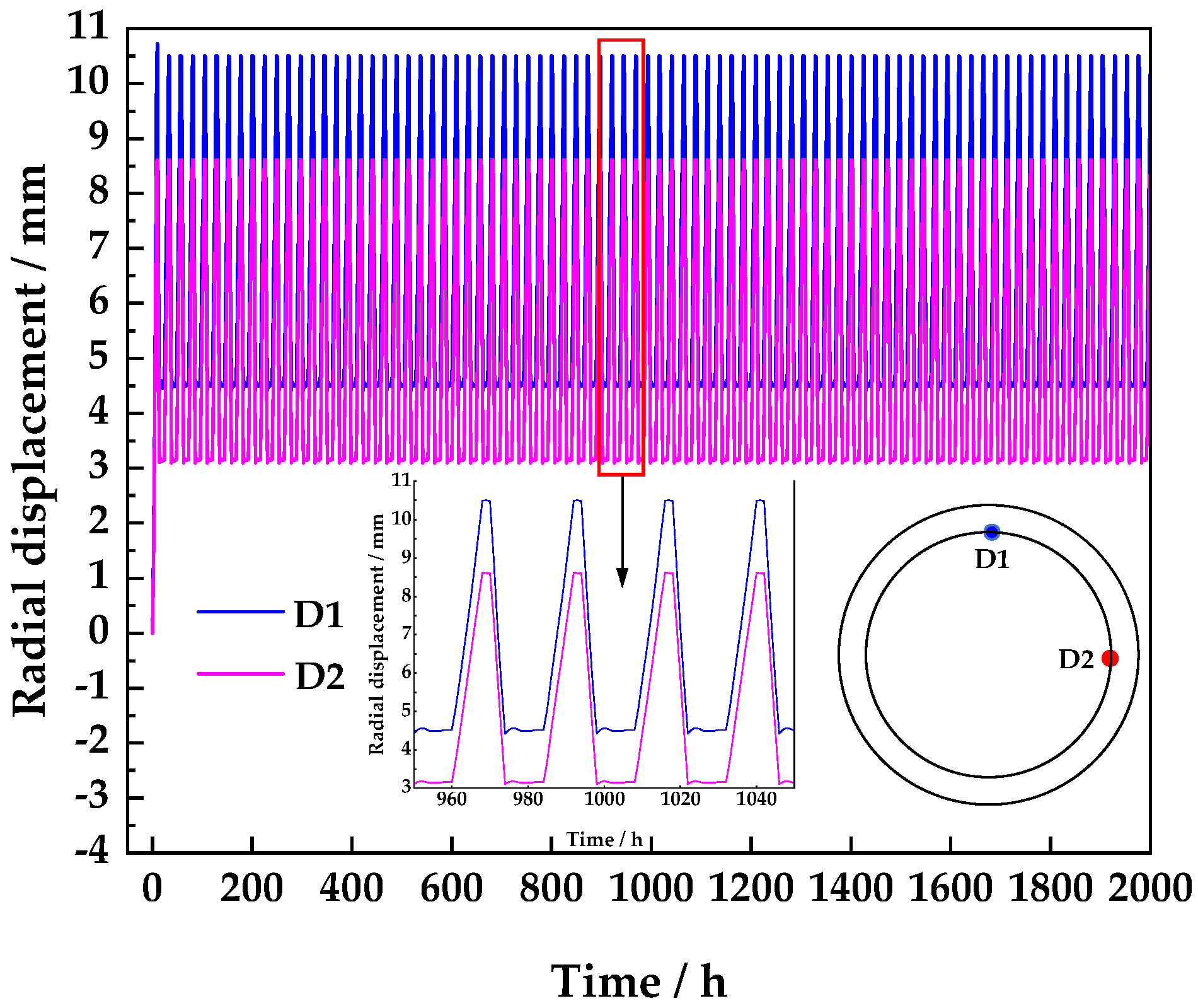

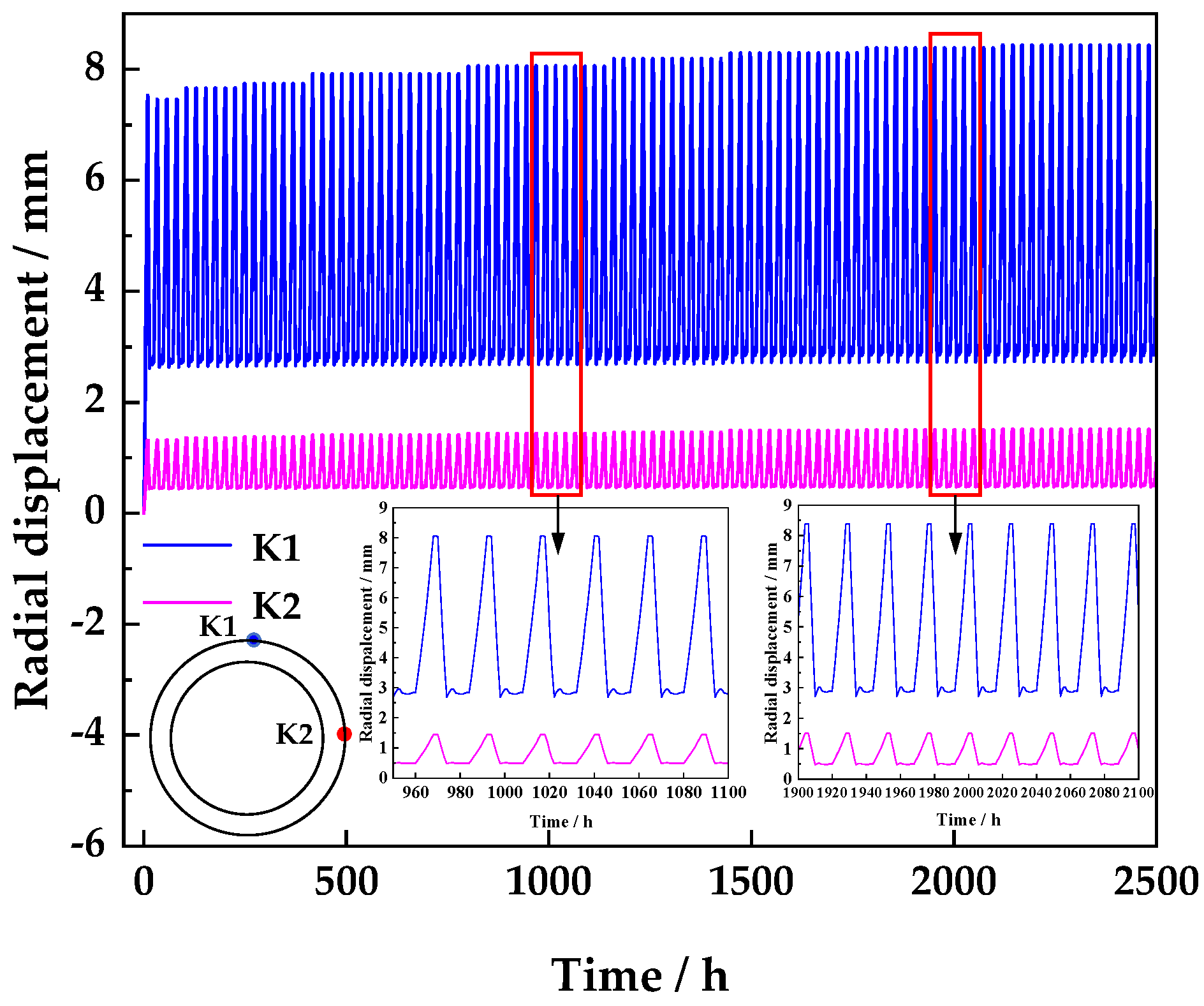
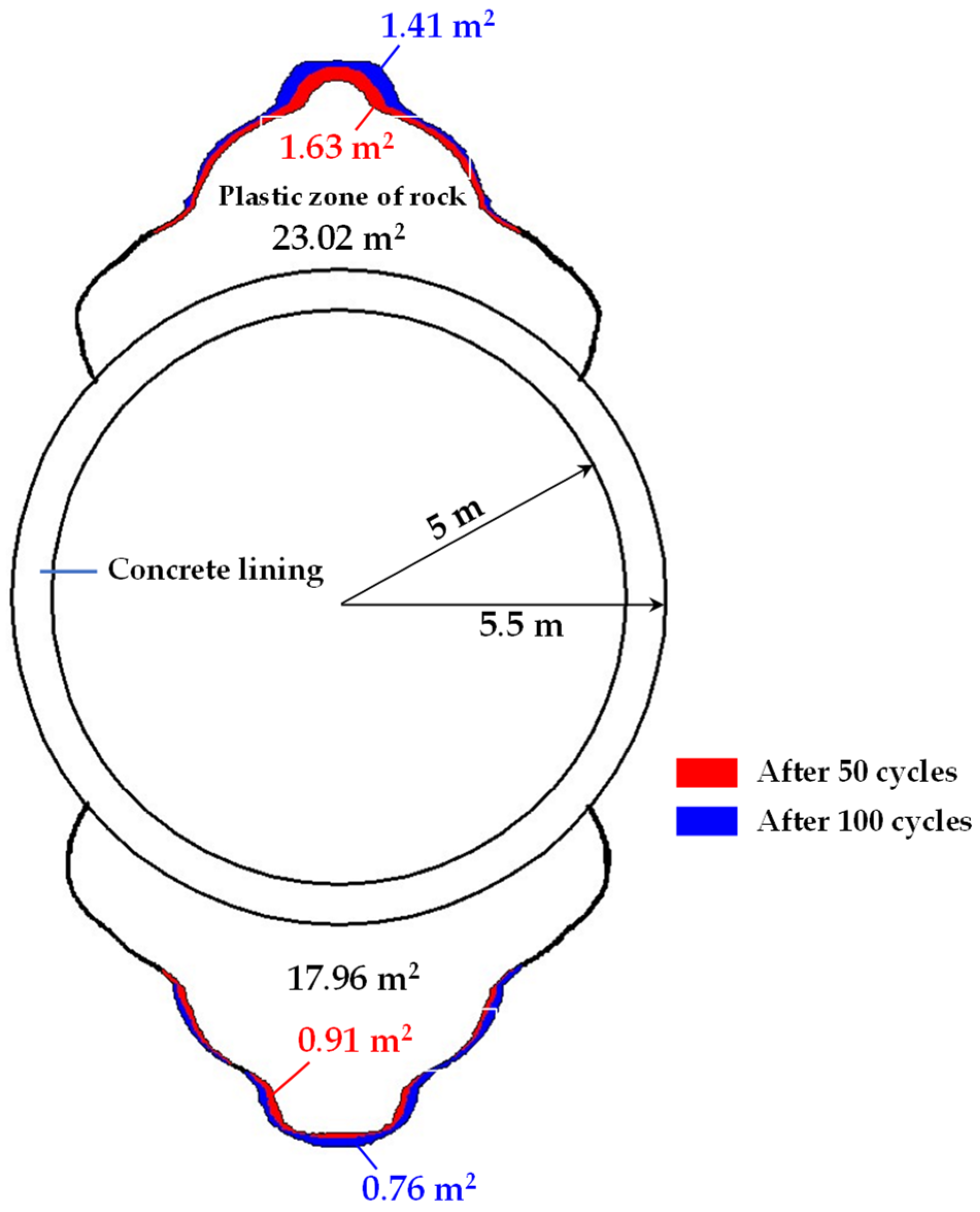
| Name | Parameter Data |
|---|---|
| Density | 2350 kg/m3 |
| Initial elastic modulus | 6.0 GPa |
| Poisson’s ratio | 0.28 |
| Internal friction angle | 45° |
| Cohesion | 1.5 MPa |
| Compressive strength | 60.8 MPa |
| Symbol | Parameter Data |
|---|---|
| ρv | 0.16 cm−3 |
| α | 45° |
| φ | 0° |
| l | 0.5 cm |
| h | 2 cm |
| f | 1.258 |
| w | 5 cm |
| Nf | 20,000 |
| b | 0.72 |
| c | 0.65 |
| Materials | Yield Criteria | Elastic Modulus E/GPa | Poisson’s Ratio v | Density ρ/(kg·m3) | Cohesion c/MPa | Internal Friction Angle ψ/(°) | Thickness d/cm |
|---|---|---|---|---|---|---|---|
| Rubber sealing layer | Linear elasticity | 10.60 | 0.45 | 920 | - | - | 0.37 |
| Plain concrete (C30) | W-W five parameters | 30 | 0.20 | 2500 | - | - | 50 |
| Initial support | W-W five parameters | 25 | 0.20 | 2500 | - | - | 18 |
| Rock mass | D-P | 6.20 | 0.28 | 2620 | 1.5 | 45 | - |
Disclaimer/Publisher’s Note: The statements, opinions and data contained in all publications are solely those of the individual author(s) and contributor(s) and not of MDPI and/or the editor(s). MDPI and/or the editor(s) disclaim responsibility for any injury to people or property resulting from any ideas, methods, instructions or products referred to in the content. |
© 2024 by the authors. Licensee MDPI, Basel, Switzerland. This article is an open access article distributed under the terms and conditions of the Creative Commons Attribution (CC BY) license (https://creativecommons.org/licenses/by/4.0/).
Share and Cite
Liu, S.; Zhang, D. Study on Long-Term Stability of Lined Rock Cavern for Compressed Air Energy Storage. Energies 2024, 17, 5908. https://doi.org/10.3390/en17235908
Liu S, Zhang D. Study on Long-Term Stability of Lined Rock Cavern for Compressed Air Energy Storage. Energies. 2024; 17(23):5908. https://doi.org/10.3390/en17235908
Chicago/Turabian StyleLiu, Shaohua, and Duoxin Zhang. 2024. "Study on Long-Term Stability of Lined Rock Cavern for Compressed Air Energy Storage" Energies 17, no. 23: 5908. https://doi.org/10.3390/en17235908
APA StyleLiu, S., & Zhang, D. (2024). Study on Long-Term Stability of Lined Rock Cavern for Compressed Air Energy Storage. Energies, 17(23), 5908. https://doi.org/10.3390/en17235908






